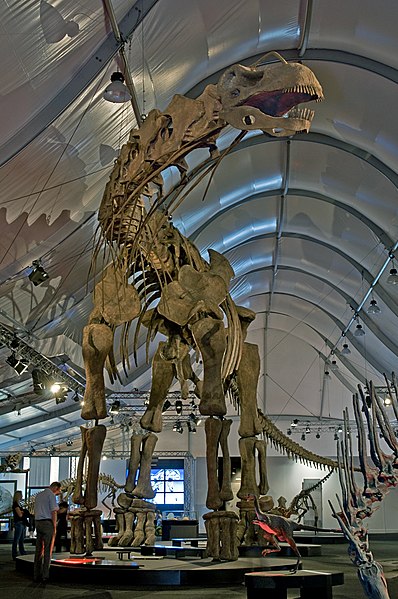
In “Evolution, sex and dinosaur necks, BBC’s Wondermonkey, Matt Walker asks (24 May 2011) whether long-necked sauropods like diplodocus evolved their necks via sexual selection:
A recent theory proposed is that sex, or more accurately sexual selection, was the main driver.The idea is that down the generations, male sauropods evolved ever longer necks to dominate rivals for the affections of females.
Dinosaurs are long dead, making it harder to test ideas about why certain traits evolved, and what they were adapted for. But evidence can still be brought to bear to analyse the different hypotheses.
Most hypotheses emphasized the practical uses of the neck, such as eating from trees, but in 2006, the idea surfaces that
… male sauropods that inherited a longer neck, caused by a chance mutation, would be more attractive to females.The length of their neck would signal their virility and suitability as a sire.
“Neck fighting” was hypothesized, with the longest neck producing the most offspring, thus fixing the trait. Great fantasy, but less imaginative researchers have pointed out
… there is no evidence in the fossil record of a sauropod species that has males with relatively longer necks than females, or visa versa, which would be expected if it was a “sexy” trait.
Among other things. The researcher who tested the sexual selection theory with modern giraffes found that it didn’t pan out.
The most arcane sexual selection theory, taken quite seriously by Darwinian biologists, is that odd sexual traits, like the peacock’s fantail, evolved because the handicap it creates tells the female that this must be a really fit male, otherwise it would not survive (fitness cost). That assumes that the peahen is doing some rather advanced calculating for the dull-witted bird she is known to be. But if she were capable of such calculations, some ask, why would she not focus on a trait that is obviously beneficial to her rather than merely costly to the male. It would be like a woman marrying a man because he is an amputee and $100 000 in debt.
Why not just dismiss sexual selection? Flannery points out that Darwin increasingly relied on it, as problems with natural selection mounted. Interestingly, based on experience, Darwin’s co-theorist, Wallace, never bought Darwin’s sexual selection theories:
Alfred Russel Wallace thought all this sexual selection talk was nonsense. Wallace, who had spent nearly twelve years with indigenous peoples, from South American natives of the Uaupés River Valley to Dyak headhunters in Borneo, pointed out to Darwin that tribal women rarely if ever sing and that what an Englishman might value as a “sweeter” voice was thoroughly uninteresting to the aboriginal peoples he knew. Even if certain cultures could be found where some women did sing, the result would seem to be a zero sum gain for the sexual selection theory and thus no explanation at all. In short, Himmelfarb points out, “Sexual selection has all the faults of natural selection and more: the suspicious facility with which it can be made to explain anything and everything, the manipulation of evidence for whatever purposes are convenient, and the invocation of ignorance when all else fails. Ignorance is resorted to even in so crucial a matter as the intellectual disparity between man and the apes” (Himmelfarb, p. 366).
For a “fitness costs”, see Antlers in heaven.